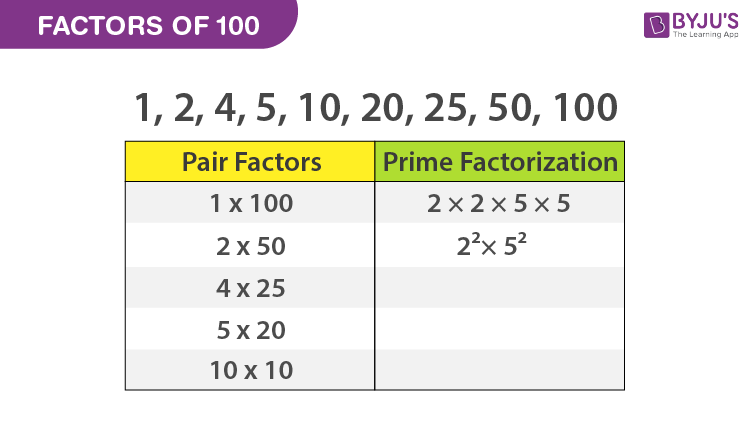The factors of 100 are the numbers, that produce the result as 100 when two numbers are multiplied together. Factor pairs of the number 100 are the whole numbers which could be either positive or negative but not a fraction or decimal number. To find the factors of a number, 100, we will use the factorization method. In the factorization method, first take the numbers, 1 and 100 as factors of 100 and proceed with finding the other pair of multiples of 100 which gives the results as an original number. In this article, we will learn the factors of 100 and the pair factors of 100 and the prime factors of 100 using the prime factorization and many solved examples.

Table of Contents:
- What are the Factors of 100?
- Pair Factors of 100
- Factors of 100 by Division Method
- Prime Factorization of 100
- Solved Examples
- FAQs
What are the Factors of 100?
The factors of 100 are the numbers that divide 100 exactly without leaving any remainder. In other words, the factors of 100 are the numbers that are multiplied in pairs resulting in an original number 100. As the number 100 is an even composite number, 100 has many factors other than 1 and the number itself. Thus, the factors of 100 are 1, 2, 4, 5, 10, 20, 25, 50, and 100.
|
Factors of 100: 1, 2, 4, 5, 10, 20, 25, 50, and 100. Prime Factorization of 100: 2 x 2 × 5 x 5 or 22 x 52. |
Pair Factors of 100
To find the positive and negative factor pairs of 100, multiply the two numbers in a pair to get the original number as 100, such numbers are as follows:
| Positive Pair Factor | Negative Pair Factor |
| 1 × 100 = 100 ⇒ (1, 100) | -1 × -100 = 100 ⇒ (-1, -100) |
| 2 × 50 = 100 ⇒ (2, 50) | -2 × -50 = 100 ⇒ (-2, -50) |
| 4 × 25 = 100 ⇒ (4, 25) | -4 × -25 = 100 ⇒ (-4, -25) |
| 5 × 20 = 100 ⇒ (5, 20) | -5 × -20 = 100 ⇒ (-5, -20) |
| 10 × 10 = 100 ⇒ (10, 10) | -10 × -10 = 100 ⇒ (-10, -10) |
Hence, the positive pair factors of 100 are (1, 100), (2, 50), (4, 25), (5, 20) and (10, 10). Similarly, the negative pair factors of 100 are (-1, -100), (-2, -50), (-4, -25), (-5, -20) and (-10, -10).
Factors of 100 by Division Method
The factors of 100 can be found using the division method. In the division method, the number 100 is divided by different consecutive integers. If the integer divides 100 exactly, then those integers are the factors of 100. First, start dividing 100 by 1 and continue with the consecutive integers.
- 100/1 = 100 (Factor is 1 and Remainder is 0)
- 100/2 = 50 ( Factor is 2 and Remainder is 0)
- 100/4 = 25 ( Factor is 4 and Remainder is 0)
- 100/5 = 20 (Factor is 5 and Remainder is 0)
- 100/10 = 10 (Factor is 10 and Remainder is 0)
- 100/20 = 5 (Factor is 20 and Remainder is 0)
- 100/25 = 4 (Factor is 25 and Remainder is 0)
- 100/50 = 2 (Factor is 50 and Remainder is 0)
- 100/100 = 1 (Factor is 100 and Remainder is 0)
Thus, the factors of 100 are 1, 2, 4, 5, 10, 20, 25, 50 and 100. If we divide 100 by different numbers other than 1, 2, 4, 5, 10, 20, 25, 50 and 100, it leaves a remainder and hence, they are not the factors of 100.
Prime Factorization of 100
The number 100 is a composite and it should have prime factors. Now let us know how to calculate the prime factors of 100.
Step 1: The first step is to divide the number 100 with the smallest prime factor, say 2.
100 ÷ 2 = 50
Step 2: Again divide 50 by 2 and the process goes on.
50 ÷ 2 = 25
Step 3: You will get a fractional number if you divide 25 by 2 and 3. So continue with the next prime factor, say 5
25 ÷ 5 = 5
5 ÷ 5 = 1
Finally, we received the number 1 at the end of the division process. So that we cannot proceed further. So, the prime factors of 100 are written as 2 x 2 × 5 x 5 or 22 x 52, where 2 and 5 are the prime numbers.
It is possible to find the exact number of factors of a number 100 with the help of prime factorisation. The prime factor of the 100 is 22 x 52. The exponents in the prime factorisation are 2 and 2. Add the number 1 with the exponents and multiply it. (2+1)(2+1) = 3 x 3 = 9. Therefore, the number 100 has 9 factors.
Video Lesson on Prime Factors

| Links Related to Factors | |
| Factors of 8 | Factors of 36 |
| Factors of 56 | Factors of 54 |
| Factors of 64 | Factors of 25 |
| Factors of 42 | Factors of 60 |
| Factors of 35 | Factors of 75 |
Examples
Example 1:
Find the common factors of 100 and 101.
Solution:
The factors of 100 are 1, 2, 4, 5, 10, 20, 25, 50, and 100.
The factors of 101 are 1 and 101.
As 101 is a prime number, the common factor of 100 and 101 is 1.
Example 2:
Find the common factors of 100 and 99.
Solution:
Factors of 100 = 1, 2, 4, 5, 10, 20, 25, 50, and 100.
Factors of 99 = 1, 3, 9, 11, 33 and 99.
The common factor of 100 and 99 is 1 only.
Example 3:
Find the common factors of 100 and 50.
Solution:
The factors of 100 are 1, 2, 4, 5, 10, 20, 25, 50, and 100.
The factors of 50 are 1, 2, 5, 10, 25 and 50.
Thus, the common factors of 100 and 50 are 1, 2, 5, 10, 25 and 50
Stay tuned with BYJU’S to know about factor 100 and the factors and prime factors of other numbers. Download BYJU’S – The Learning App for better experience and clarification and also watch interactive videos.
Frequently Asked Questions on Factors of 100
What are the factors of 100?
The factors of 100 are 1, 2, 4, 5, 10, 20, 25, 50 and 100.
What is the prime factorization of 100?
The prime factorization of 100 is 2 x 2 × 5 x 5 or 22 x 52.
What are the positive pair factors of 100?
The positive pair factors of 100 are (1, 100), (2, 50), (4, 25), (5, 20) and (10, 10).
What are the negative pair factors of 100?
The negative pair factors of 100 are (-1, -100), (-2, -50), (-4, -25), (-5, -20) and (-10, -10)
Is 24 a factor of 100?
No, 24 is not a factor of 100. If 100 is divided by 24, it leaves a remainder, and hence 24 is not a factor of 100.

Comments